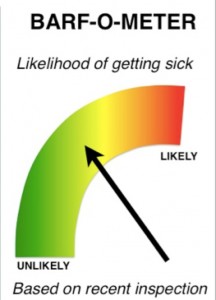Guelph, the self-proclaimed Canadian capital of all things food – it’s not – has decided after 12 years to boldly follow Toronto’s lead and make  available some form of restaurant inspection disclosure.
available some form of restaurant inspection disclosure.
Not signs, not media, but a website.
The Wellington-Dufferin-Guelph Public Health Unit says a new online system for public access to food safety inspection records will be ready by February 2013.
“You will be able to go to the website and access the restaurant inspection results,” communications manager Chuck Ferguson told the Guelph Mercury.
Called, Check Before you Choose, it will start with information from October 2012 and maintain a two-year record going forward.
The website will show when the last inspection was done, what specific issues were found and what action was taken as a result. Infractions are classified as critical or non-critical depending on whether they pose an immediate risk to public health.
Guelph graduate Sylvanus Thompson, the associate director at Toronto Public Health responsible for food safety, says that the Toronto system has been adapted and modified by cities in Ontario, the U.S. and Europe.
Although showing a direct connection between the regulations and less people getting food poisoning is difficult, he says compliance has increased from less than 50 per cent in 2000 to 90 per cent.
“We are also seeing less of the type of infractions that contribute to foodborne illness and less cases of foodborne illness in Toronto,” he says.
In 2011 the Guelph Public Health Unit inspected 1,365 locations. It issued only one ticket but 1,204 of the inspections required follow-up.


 safety assessments more readily accessible to the public.
safety assessments more readily accessible to the public. movie is about me, or us).
movie is about me, or us).
 Watch proclaims that doo doo chicken is the new pink slime
Watch proclaims that doo doo chicken is the new pink slime the roughly 13,154 kilograms of frozen turkey carcasses to be re-introduced into the food chain.
the roughly 13,154 kilograms of frozen turkey carcasses to be re-introduced into the food chain..jpeg) he had eaten some of the turkeys and no one got sick," Akerstream said.
he had eaten some of the turkeys and no one got sick," Akerstream said.